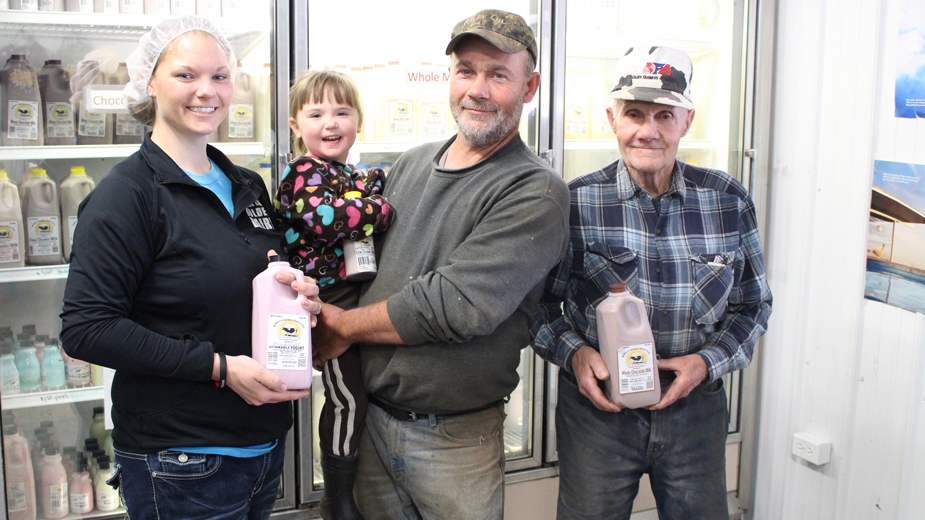Baker’s Dairy Rises to Top with New Flavors
NEW WATERFORD, Ohio – As with much in life, the product that for the past six years has helped Baker’s Golden Dairy increase its business came about by chance.
In 2011, the dairy farm in New Waterford produced only regular, chocolate- and strawberry-flavored milk. Then one day “by accident we didn’t rinse out the lines,” recalls Kasey Hudson, the daughter of the owners of the farm. “We ended up with chocolate-strawberry.”
The resulting product wasn’t very good – and it’s not the way Baker’s Golden Dairy flavors its milk today. But it did give her an idea.
Hudson began researching other dairy farms on the internet, eventually finding one that specialized in blueberry-flavored milk.
“I thought, ‘We could be like them,’ ” she says.
Hudson set herself to the task of coming up with various flavors. Her father, Kevin, was responsible for making them palatable.
“At the beginning it was a little risky,” he says as he laughs. “There was a bunch that didn’t go anywhere but down the drain.”
On days the Bakers bottle their milk, the namesake of the farm can be found tending to the pasteurization tank and mixing the ingredients for the flavors. Baker says the key to making chocolate milk is mixing the chocolate with the sugar before the flavorings go into the tank, “to get it to blend in. If you don’t get that mixed up, you’re in trouble,” he says.
Today, Baker’s carries a variety of flavors that include butterscotch, root beer, cotton candy and black cherry.
“It’s definitely helped our processing plant take off,” Hudson says.
Most of the milk is shipped to area stores while some is used to stock the farmers’ retail store. Anything leftover is sent to Minerva Dairy where it’s used to make cheese and butter.
For Baker, a fifth-generation dairy farmer, the experience is new. For most of his life the processing of the milk was always done elsewhere. That all changed in 2011.
With three of his four children showing an interest in the family farm, Baker needed to raise profits. It came down to a choice between increasing the number of cows and bottling its own milk.
He chose the latter, opening a processing plant on the farm. “There’s only three or four of us in Ohio that bottle our own milk on the farm,” he says.
Baker’s has some 120 cows, of which 90 or so are milking at any given time.
“That number is constantly changing with heifers coming in and older cows going out,” says Hudson, adding that sending the cows too old to milk to auction is one of her least favorite aspects of farming, because “when they’re here they’re like your kids.”
The farm sits on 150 acres of rolling hills just off state Route 7 in Columbiana County. On it can be found the fields that produce the cows’ feed, the stables and the processing center, which also serves as the retail store.
What you aren’t likely to find is a cashier. In that case, customers purchase whatever they want on the honor system.
“We have a sheet where they write down what they bought,” Hudson says. “We have a box on the side of the desk where they put their money and out the door they go.”
While the Bakers did catch someone stealing on Easter Sunday, Hudson says that for the most part the system, like the flavored milk, has been a big success.
Still, the family business isn’t immune to the economic forces that plague the dairy industry. Dairy farmers across the United States continue to struggle with nearly as many theories about why as there are agricultural economists.
The recent popularity of competing products such as soy or almond milk seem likely culprits, but Hudson is quick to point to the lactose-intolerant makeup of a large portion of that customer base, and that those people wouldn’t be buying milk anyway.
What’s also true is that Americans are drinking less milk than they used to.
Data from the U.S. Department of Agriculture show that annual consumption of milk per capita in the country has dropped from 247.1 pounds in 1975 to 155.3 pounds in 2015.
Those numbers tell only part of the story.
While traditional milk sales are down, the number of Americans who eat products made from milk – such as cheese and ice cream – is on the rise. The daily consumption of all dairy products in the United States rose from 119.1 billion pounds in 1975 to 212.3 billion pounds in 2015.
Those numbers suggest that a more likely cause is simple supply and demand.
“There’s lots of milk, the prices are down,” says Baker of the market.
Hudson says dealing with the uncertainty of milk prices has been a “hard fact to swallow,” which is why the family wants to branch out and develop more products that use their milk.
“The state of Ohio is hurting. We’ve heard that people have actually been dumping milk around the area,” she says.
To diversify its business, Baker’s recently introduced another new product: drinkable yogurt,
“It’s cultured milk that incubates in our pasteurizer for six hours until it’s ready. Then it’s flavored and bottled up,” Hudson says.
Like the milk, the drinkable yogurt comes in several flavors.
It’s something the eldest Baker, Kevin’s father Harold, could have never imagined.
“I like a root beer float but I don’t care for the root beer milk,” he says.
“It’s hard to believe, but when I was growing up we used horsepower,” the 87-year-old Baker remembers.
While some aspects of the family business have changed, in most ways it’s exactly the same as it was when Harold began to learn the trade.
The cows are still milked twice a day – 3:30 a.m. and 3:30 p.m. And it’s still hard work.
“You’re on call seven days a week,” Kevin says. “Something goes wrong, you gotta be here.”
One thing that can go wrong is what Baker calls fresh cows.
“A fresh cow is a cow that’s having a calf,” he says, “and if there’s one that’s going to be in trouble, it will be in the middle of the night.”
For some family farms the promise of long hours and unpredictable profits are a tough sell to younger generations and that was almost the case with Hudson.
In 2007, she left the farm to go to school for nursing but found she couldn’t stay away.
“I missed my cows,” she says. Hudson has a soft spot in her heart for one cow in particular, a red and white Holstein she named Candy: “She is a doll.”
Two of Hudson’s three brothers have also decided to stay on the farm.
“It’s very important. We want to keep it in the family,” Hudson says. “Dad wants the younger generation, our kids, to take it over.”
“It makes me feel good that someone is still interested in farming and agriculture,” says Baker. “It’s not easy.”
Baker’s father impressed on him his desire to pass the farm on to his children and grandchildren, just as his father impressed it on Harold.
“When I was out of high school he told me he wanted me to stay on the farm and keep the Baker name on it,” the eldest Baker recalls. “I said I’d do the best I could. You never know what you might run into, but so far we’ve been fortunate.”
Pictured: Kasey Hudson and her daughter Justyce, her father, Kevin Baker, and his father, Harold.
Copyright 2024 The Business Journal, Youngstown, Ohio.



